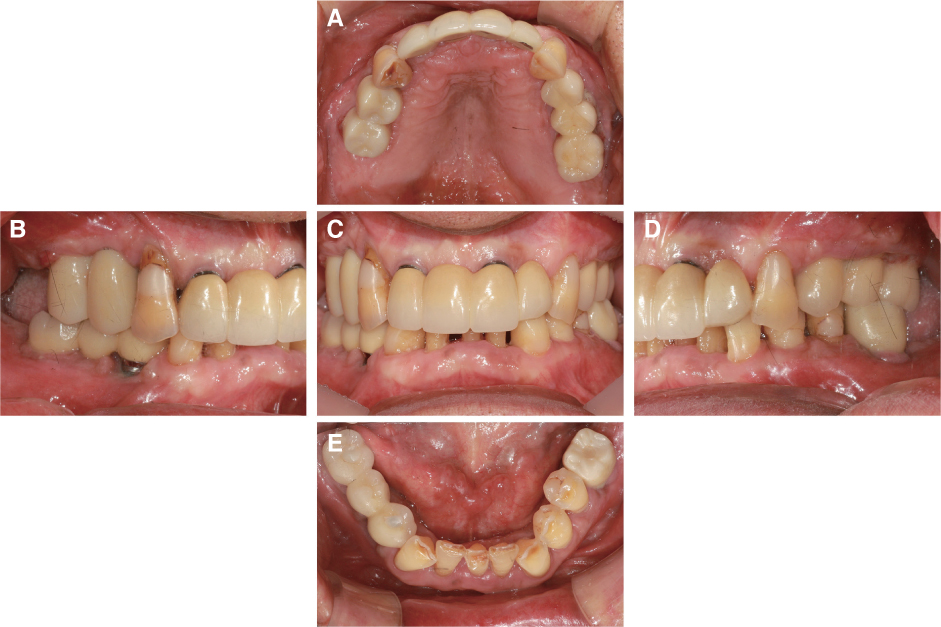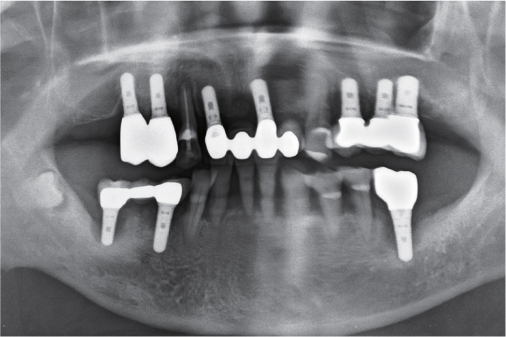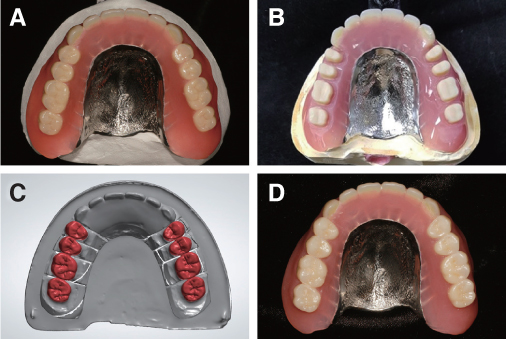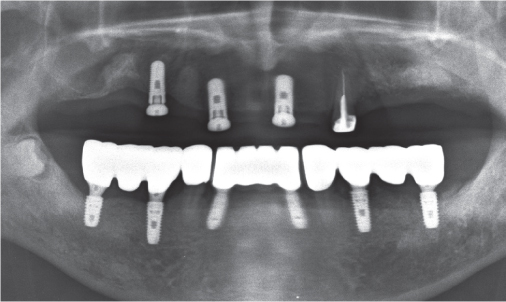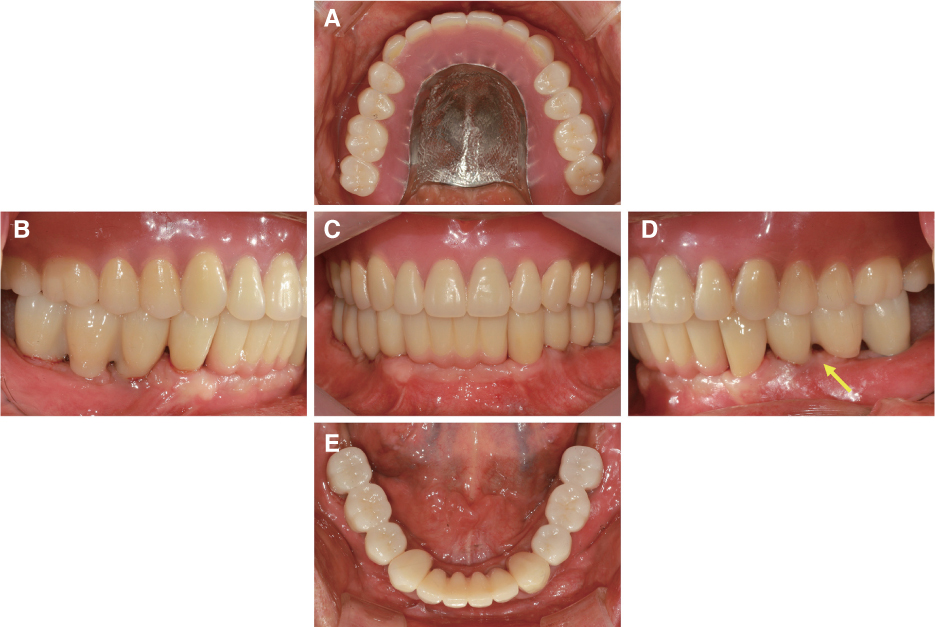J Korean Acad Prosthodont.
2019 Oct;57(4):416-424. 10.4047/jkap.2019.57.4.416.
Full mouth rehabilitation in a patient with peri-implantitis: A case report
- Affiliations
-
- 1Department of Prosthodontics, School of Medicine, Ewha Womans University, Seoul, Republic of Korea. prosth@ewha.ac.kr
- KMID: 2461149
- DOI: http://doi.org/10.4047/jkap.2019.57.4.416
Abstract
- Peri-implantitis appears in almost 20% of patients who received implant treatment, and increase in its number is inevitable as time goes by. Although it can be treated by both non-surgical and surgical procedures, in cases which include severe bone loss, explantation and rehabilitation may be necessary. Careful treatment planning and considerations to prevent recurrent peri-implantitis should be taken into account. In the following case presented, a patient with chronic periodontitis and peri-implantitis was successfully rehabilitated after removal of several implants. Extraction and explantation of multiple teeth and implants were followed by full mouth reconstruction with fixed implant prostheses on the mandible and implant retained overdenture on the maxilla. Surgical and prosthetic measures to prevent recurrent peri-implantitis were taken into consideration.
Keyword
MeSH Terms
Figure
Reference
-
1. Mombelli A, Müller N, Cionca N. The epidemiology of peri-implantitis. Clin Oral Implants Res. 2012; 23 Supple 6:67–76.
Article2. Lindhe J, Meyle J;. Group D of European Workshop on Periodontology. Peri-implant diseases: Consensus Report of the Sixth European Workshop on Periodontology. J Clin Periodontol. 2008; 35:282–285.
Article3. Heitz-Mayfield LJ. Peri-implant diseases: diagnosis and risk indicators. J Clin Periodontol. 2008; 35:292–304.
Article4. Karoussis IK, Salvi GE, Heitz-Mayfield LJ, Brägger U, Hämmerle CH, Lang NP. Long-term implant prognosis in patients with and without a history of chronic periodontitis: a 10-year prospective cohort study of the ITI Dental Implant System. Clin Oral Implants Res. 2003; 14:329–339.
Article5. Lang NP, Wilson TG, Corbet EF. Biological complications with dental implants: their prevention, diagnosis and treatment. Clin Oral Implants Res. 2000; 11:146–155.
Article6. Tallarico M, Canullo L, Wang HL, Cochran DL, Meloni SM. Classification systems for peri-implantitis: A narrative review with a proposal of a new evidence-based etiology codification. Int J Oral Maxillofac Implants. 2018; 33:871–879.
Article7. Naert I, Duyck J, Vandamme K. Occlusal overload and bone/implant loss. Clin Oral Implants Res. 2012; 23:95–107.
Article8. Lee CT, Huang YW, Zhu L, Weltman R. Prevalences of periimplantitis and peri-implant mucositis: systematic review and meta-analysis. J Dent. 2017; 62:1–12.
Article9. Kotsovilis S, Karoussis IK, Trianti M, Fourmousis I. Therapy of peri-implantitis: a systematic review. J Clin Periodontol. 2008; 35:621–629.
Article10. Jepsen S, Berglundh T, Genco R, Aass AM, Demirel K, Derks J, Figuero E, Giovannoli JL, Goldstein M, Lambert F, Ortiz-Vigon A, Polyzois I, Salvi GE, Schwarz F, Serino G, Tomasi C, Zitzmann NU. Primary prevention of peri-implantitis: managing peri-implant mucositis. J Clin Periodontol. 2015; 42:S152–S157.
Article11. Schou S, Berglundh T, Lang NP. Surgical treatment of periimplantitis. Int J Oral Maxillofac Implants. 2004; 19:140–149.12. Mombelli A, Lang NP. The diagnosis and treatment of peri-implantitis evidence for a microbial cause of peri-implant infections. Periodontology. 2000; 17:63–76.13. Ding L, Zhang P, Wang X, Kasugai S. A doxycycline-treated hydroxyapatite implant surface attenuates the progression of peri-implantitis: A radiographic and histological study in mice. Clin Implant Dent Relat Res. 2019; 21:154–159.
Article14. Becker W, Becker BE, Newman MG, Nyman S. Clinical and microbiologic findings that may contribute to dental implant failure. Int J Oral Maxillofac Implants. 1990; 5:31–38.15. Ozeki K, Okuyama Y, Fukui Y, Aoki H. Bone response to titanium implants coated with thin sputtered HA film subject to hydrothermal treatment and implanted in the canine mandible. Biomed Mater Eng. 2006; 16:243–251.16. Roos-Jansåker AM, Renvert H, Lindahl C, Renvert S. Nine- to fourteen-year follow-up of implant treatment. Part III: factors associated with peri-implant lesions. J Clin Periodontol. 2006; 33:296–301.
Article17. Salvi GE, Monje A, Tomasi C. Long-term biological complications of dental implants placed either in pristine or in augmented sites: A systematic review and meta-analysis. Clin Oral Implants Res. 2018; 29:294–310.
Article18. Bremer F, Grade S, Kohorst P, Stiesch M. In vivo biofilm formation on different dental ceramics. Quintessence Int. 2011; 42:565–574.19. Katafuchi M, Weinstein BF, Leroux BG, Chen YW, Daubert DM. Restoration contour is a risk indicator for peri-implantitis: A cross-sectional radiographic analysis. J Clin Periodontol. 2018; 45:225–232.
Article
- Full Text Links
- Actions
-
Cited
- CITED
-
- Close
- Share
- Similar articles
-
- Risk factors of peri-implantitis: a narrative review
- Unusual bone regeneration following resective surgery and decontamination of peri-implantitis: a 6-year follow-up
- Management of peri-implantitis associated with tear-like implant fracture: case reports
- Laser therapy in peri-implantitis treatment: literature review
- Prevalence and risk factors of peri-implantitis: A retrospective study

